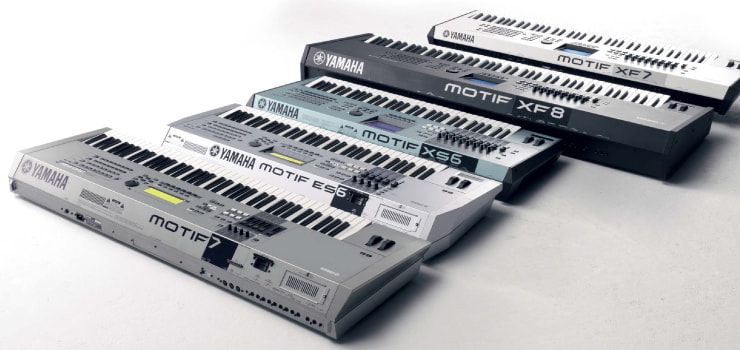[Chapter 5] The Complete Musical Instruments of the MOTIF Series
- Home
- 40th Anniversary Model
- History
- Chronology
- Product Lineup
- News
- Artist Comments
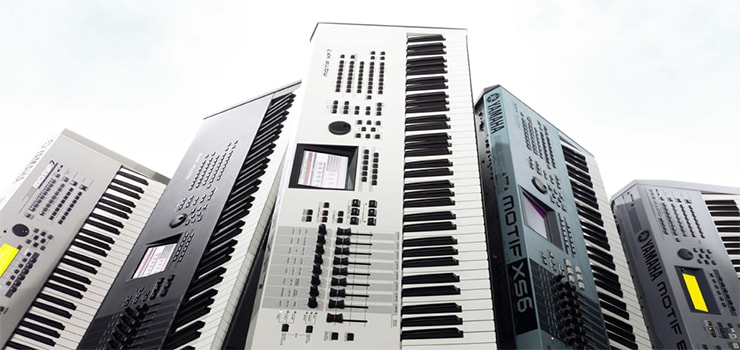
The MOTIF ® (2001), MOTIF ES (2003), MOTIF XS (2007), and MOTIF XF (2010) were released as successive flagship-model products. Yamaha synthesizers have aided in the creation of many famous songs representative of their era since the release of the first model, the SY-1. In 2014 Yamaha celebrated 40 years of making synthesizers, and in commemoration released a version of the MOTIF XF in pure white, a coloring that represents a return to the roots of Yamaha synths.
[Chapter 5] The Complete Musical Instruments of the MOTIF® Series
The ultimate workstation
Yamaha's decision to listen more closely to the voices of customers paid dividends with instruments such as the S80 winning great praise as stage keyboards among other achievements. That having been said, efforts to develop a successor to the workstation synths of the SY Series and the EX Series failed to deliver any instruments that went on to become massive hits.
As a result of remarkable advancements in PC technologies and the lower prices that they brought about, the early nineties saw music production gradually migrate towards systems with PCs at their core. Yet one still needed a considerable amount of technical expertise in order to get the most out of the computers of the time, and this set the bar a little too high for the pure musician. As a result, the workstation came to provide a convenient one stop shop for their production needs. In the latter half of the decade, further significant progress in the Windows and Macintosh operating systems made it possible for those with little or no computer skills to use PCs with confidence, and many musicians—both professionals and amateurs—started to build their music production systems around computers. Although the workstation excelled in its ability to make serious music without the need for any other equipment, it began to fall short of the requirements of the market as a result of these developments. In response, we refocused our development of new workstation synths on the following three goals.
1. Great sound
New Yamaha workstations would need to deliver highly practical and expressive sounds in both recording and live settings. This does not refer only to the voices of individual instruments, but also to an overall sound capable of stimulating the creativity of the musician. The synthesizer is generally expected to deliver a myriad of different sounds, but in order for it to be treated as a serious musical instrument, the quality of these sounds is paramount.
2. Easy to make music
We could not allow confusing modes of operation to distract the user from the creative process of music making. For this reason, we decided to leverage the high quality of our hardware in order, for example, to enhance the user interface and make it possible to create fantastic sounding music in a very short time.
3. Computer integration
Adopting a radical new approach for the workstation synthesizer, we realized that greater compatibility and affinity with computers must be achieved. Our workstations could not only be suited to the production of music as standalone, fully independent devices; rather, they would also need to play a key role within systems built around the PC.
Dawn of the MOTIF era
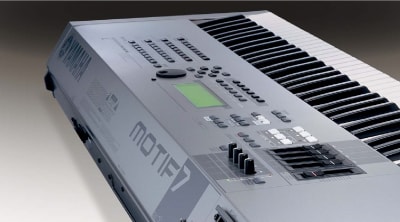
Yamaha had been working on a new form of workstation developed under the code name Kangaroo, and we set about enhancing it as a top class instrument capable of satisfying all three of the above goals. To this end, we focused on further improvements to our PCM waveforms (i.e., the raw data for sampled sounds), which had been steadily improved since the development of the S80, intelligent arpeggiator functionality, and support for the remote control of digital audio workstations (DAWs). Developed as a commercially viable product based on the Kangaroo project, the MOTIF workstation synthesizer had a massive impact on the synth world upon its release in 2001.
Prior to the MOTIF, our EX Series workstations had been equipped with many of the tone generation systems that we had developed to date, such as VL and AN. However, Yamaha selected AWM2 as the fundamental tone generation technology for the MOTIF, and with all of these other tone generation systems supported in the form of plug-in boards, we achieved a perfect balance between simplicity, convenience, and expandability. In the early 2000s, audio loops—that is, short sections of drum and instrument tracks several beats in length—had started to become very popular with music producers, and in order to support this approach to music making, MOTIF workstations featured an Integrated Sampling Sequencer (ISS). Using this functionality, the synths could automatically detect the beats in an audio loop, slice it up, and apply a natural sounding release to each slice. Intelligent time stretching could then be applied—in other words, the audio loop could be played back at different tempos without sounding unnatural. The ISS could also rearrange the order of the slices in order to create totally new grooves. And because pitch could be changed without having to modify the tempo, the ISS was extremely effective with pitched musical phrases as well as drum loops. Thanks to this innovative feature, MOTIF owners could now make beats and tunes in a highly intuitive fashion by combining audio and MIDI phrases—functionality that is now taken for granted in the modern DAW.
The MOTIF also featured an intelligent arpeggiator that proved highly effective both when playing live and arranging. The term "arpeggiation" may conjure up the image of a musician holding down a chord and his or her synth responding by automatically playing the constituent notes in sequence up and down; however, the MOTIF went far beyond this approach in its implementation. For example, an arpeggiator configured to play the notes G, A, and G when G was played on the keyboard could also be set to do so only in a certain higher band of velocities, meaning that a trill effect could be produced with voices such as flute or guitar just by playing a little harder. So rather than simply generating basic upward and downward phrases, the MOTIF arpeggiator could also be used in a variety of ways to make performances more expressive, effortlessly breathing life into parts that sounded uninspiring when played using the keyboard alone. It is not surprising, therefore, that arps became one of the most popular features of the MOTIF.

The MOTIF 6/7/8 catalog (English version)
Hardware innovation
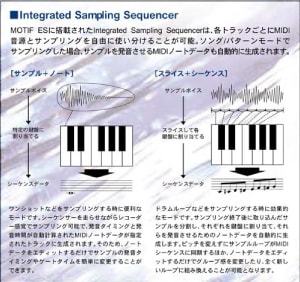
An explanation of the Integrated Sampling Sequencer(ISS), from the MOTIF 6/7/8 Japanese catalog
In addition to wide ranging improvements in software, the MOTIF also featured hardware with specifications that differed markedly from those of the Yamaha synths that had gone before. For a start, all of the instruments in this series had the same tone generation functionality, regardless of keyboard length. Prior to this, the number of keys making up a synth's keyboard, its body dimensions, and its feature lineup usually depended on whether it was intended for professionals, stage use, or beginners. However, the 61-, 76-, and 88-key variations of the MOTIF synths were all equipped with exactly the same tone generation functionality. The keyboard from the 88-key model had a slightly different mechanical design, but there was no difference at all between the three variations in terms of the number of dials and voices. If, for example, you owned a 61-key MOTIF but would need to play a 76- or 88-key model from a rehearsal or recording studio or rented to bring on tour, this innovative approach meant that you could do so in complete confidence and without anything seeming unfamiliar. This advantage was further enhanced by the inclusion of a flash memory slot, allowing voices and sequence data to be stored on memory cards. With all required data stored on a single card, therefore, you could easily recreate your preferred playing environment on any MOTIF anywhere in the world.
Meanwhile, faders and dials ergonomically arranged at the left of the top panel could be used for real-time control of the MOTIF's voices and arps as well as DAW software running on a PC. Elegantly achieving our goal of computer integration, these features allowed the MOTIF synth to be built into the heart of a computer-based production system connected via USB or MIDI cables.
Yet the MOTIF also packed in many more features that were critical to a professional workstation synthesizer. For example, the sampling libraries that had become standard tools among the professional producers of the day could be imported, and the instrument also supported digital output for direct digital connection to studio equipment. In addition, the instrument's physical design and colors looked great on stage. From this perspective also, the MOTIF Series incorporated far more feedback from the market than was reflected in our three original goals.
Offering so much to the musician, it comes as no surprise that the MOTIF Series was released to great acclaim. In terms of sound quality, frequent improvements made to the built-in waveforms primarily used as the basis of backing patterns meant that sounds like the electric piano, bass, and electric guitar were singled out for particular praise. The quality of the instrument's built-in audio effects was also recognized right away, and the MOTIF quickly found itself a permanent feature in many professional recording venues. Meanwhile, the ISS made it possible for music production techniques focused on drum sampling to be applied with ease, and methods previously available to only a small number of dance music producers could now also be used by pop-music artists. Given that the hip-hop sound started to make inroads into the US charts only after the MOTIF was introduced, this family of synths clearly had a major impact on the music scene of the day.
Further evolution to Mega Voices
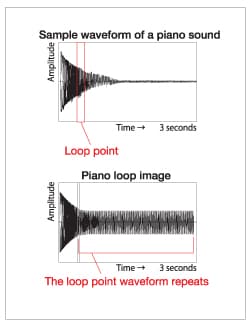
Figure 1 Examples of sampling piano sound.
Having regained their groove, the developers of the MOTIF set about planning the synth's second generation, and the most notable change in this—the MOTIF ES—was a doubling of the memory provided for built-in waveforms. In specific terms, the 85 MB of memory originally available for this data was increased to 175 MB, allowing much more sampled data to be stored on the instrument. One could be forgiven for thinking that this memory boost simply allowed more individual voices to be stored, but the availability of waveform memory is actually extremely important in enhancing the quality of sampled voices. To understand why, let's look at the example of a piano voice. As shown in the illustration, a piano sample slowly attenuates over time, and in the case of a grand piano, it could take dozens of seconds for each note to fade away completely. Storing all of this data on a synth would soon exhaust the available memory, and therefore, looping is usually applied as an alternative.
Sticking with our piano example, the attack portion of the sound comprises an extremely complex blend of harmonics that changes rapidly over time; however, the same basic waveform repeats in the release portion, gradually decaying in volume. We can, therefore, simulate the way in which piano notes actually fade out by looping a suitable length of the release portion and slowly reducing its volume. Waveform data from behind the looped portion would no longer be needed, and when this is removed from the sampled sound, less on-board memory is required for storage. If, however, the loop points must be positioned too far forward due to memory constraints, it becomes much more difficult to reproduce the delicate nuances of the sampled instrument, and the resulting voices become sterile and mechanical. In other words, when more memory is available for storing sample data, more realistic, higher quality sounds can be replicated. In addition, the subtle noises produced when playing a real instrument—in the case of our piano, the sounds of mechanisms such as the actions and pedals—can also be sampled when more memory is available, and when properly mixed with the musical sounds, they make the simulation much more realistic. In the MOTIF ES, we were able to achieve a level of musical expressiveness that memory limitations made impossible on the original MOTIF, significantly boosting the overall quality of the synth's sound.
Meanwhile, a technology known as Keyboard Mega Voice made all of the nuances of an acoustic instrument's sound instantly playable. For example, guitar mutes and harmonics could in the past only be accessed by individually loading the corresponding programs, but Keyboard Mega Voices could also produce these sounds in response to specific key velocities and other performance data. They too played a critical role in making the MOTIF ES a much more expressive musical instrument.
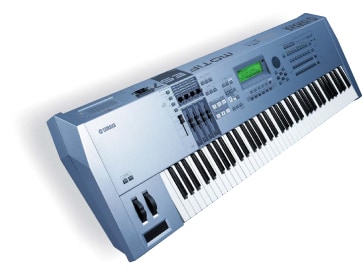
MOTIF ES7
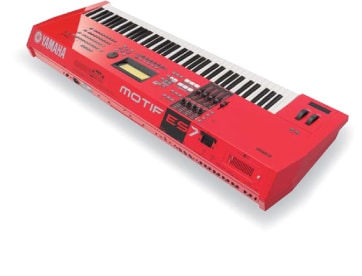
The MOTIF ES7 , a Red prototype that was never released
Revolutionary advancements in the MOTIF XS
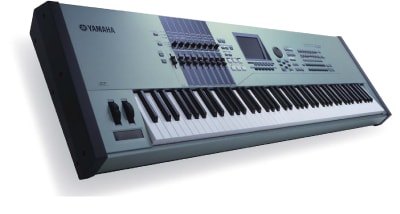
MOTIF XS8
As the second-generation MOTIF ES made steady inroads and the MOTIF Series synths became a favorite of amateur and professional musicians alike, expectations for the next generation began to grow. The third installment in this series—the MOTIF XS—further increased the memory available for waveforms, but it also provided a great many other enhancements in terms of functionality.
First of all, we changed the operating system used to drive the synthesizer's on-board programs. Earlier operating systems had been specially designed for synthesizer development, and therefore, drivers had to be built on a case by case basis for functions that needed to communicate with a computer. This extremely inefficient and time consuming situation was made even worse by the fact that the drivers needed to be updated whenever a computer OS was upgraded. As a solution, we switched to operating systems such as Linux, which had originally been developed for use on computers. This allowed us to resolve all compatibility issues and also boosted the pace of development. What's more, it became much easier to release subsequent OS updates that added new functionality to the synths. From this perspective, the MOTIF XS could almost be described as a computer with a built-in piano keyboard.
With the MOTIF XS, we also greatly enhanced the functionality of the arpeggiator, now a key feature of this synth family. In contrast to earlier MOTIFs, where phrases were combined from multiple voices each using one type of arp, four arpeggiators could now be driven in parallel for much more complex phrasing. It may at first seem that simply combining four of the trill or up/down type arps described above would not be musically effective; however, this all starts to change when you consider that arpeggio note data can also be assigned to drum phrases.
MOTIF synths can be played in two different modes—Voice mode, which lets the musician focus on all the nuances of one specific instrument, such as piano or guitar, and Performance mode, which allows a number of these voices to be layered on the keyboard and played at the same time. Using the four arpeggiators of the MOTIF XS in Performance mode makes it possible to simultaneously play sequenced phrases of up to four voices. If, for example, the first of these voices is set to drums, its arpeggiator can be used to play a drum loop. Bass could be selected for the second voice and the corresponding arpeggiator could play bass guitar phrases; meanwhile, if piano were selected for the third, a backing part could be played by the corresponding arpeggiator. Finally, selecting guitar for the last voice and having its arpeggiator play a strumming phrase would round out a complete backing pattern.
It is important to bear in mind that this is not the same as simply programming a multi-part backing sequence: the fact that the pattern is arpeggiator driven means that it can instantly respond to the notes played. While the drum phrase would normally be set to play the same loop, the other three voices could change in real time based on the notes played. The MOTIF XS could also identify chords based on the keys held down, and this paved the way for powerful functionality allowing the player to effortlessly play intricate backing phrases with chords changing instantly as he or she desired.
Of course, many of the other synthesizers available at the time had pattern sequencers with support for chord changes, but what made the MOTIF XS special was a more realistic-sounding approach that also allowed the phrases themselves to be changed based on velocity data from the keyboard. For example, the drum pattern's arpeggiator could be set to produce a crash cymbal and kick variation in response to the playing of a note above a certain velocity (or strength). This made it possible to easily produce accent cymbals or syncopated 8th- or 16th-note rhythms during actual performances. Rather than switching to "pattern" or another similar term, Yamaha has stuck firmly with "arpeggiator" to describe this ability to freely control phrases in line with the player's wishes, and it has become synonymous with the MOTIF Series.
Further enhancement of core functionality in the MOTIF XF
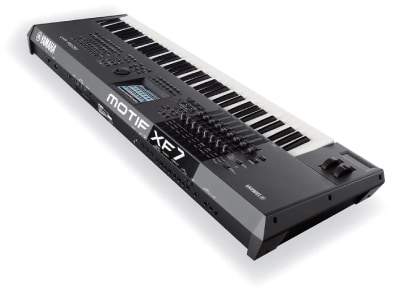
MOTIF XF7
The current MOTIF XF was introduced in 2010, further building on the basic functionality of the MOTIF XS of three years earlier. The memory available for built-in waveforms has been increased from 355 to 741 MB, and this synth is also equipped with more inspiring and powerful voices. In addition, consideration has been given to expandability with, for example, support for flash memory expansion modules that can boost the available sampling and waveform data to a maximum of 2 GB. Its predecessor, the MOTIF XS, also provided for voice expansion, but not using flash memory. For this reason, any expansion waveform data had to be reloaded every time the instrument was turned on. With the addition of support for flash memory expansion modules, expansion voices can now be loaded into the MOTIF XF just as easily as presets. Meanwhile, effects and various other synth features can be updated using software upgrades, meaning that the synth's owners benefit from ongoing enhancements without having to purchase new hardware.
In developing the MOTIF XS, we also reviewed the synth's basic hardware functionality. Many internal components associated with sound quality have been upgraded, and the driver voltage for analog circuitry was also increased from that of the MOTIF XS. As a result, the punch and fatness of sounds has been tremendously improved.
Leveraging all of the Yamaha synthesizer expertize acquired over the years in the realization of a perfect balance between content and technology, the fourth-generation MOTIF XF condenses the successes of every member of the MOTIF Series into a single instrument. Since its release, this remarkable synth has become a favorite of a great many musicians. Having matured rapidly through the first decade of the 21st century from the original MOTIF to the XF, this series has developed an enviable reputation for ease-of-use, great sound, and excellent performance. As such, the MOTIF has taken the place of ultimate workstation synthesizer in all but name. With an adoption rate for recording studios, tour rentals, and a diverse array of other applications that rivals that of the incredibly successful DX7, the MOTIF Series continues today to support musicians all over the world.
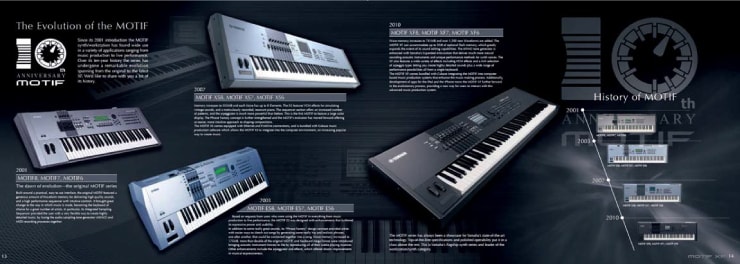
Groundbreaking models released during the 10 years after the release of the first MOTIF were introduced.
Crossover to other models and the CP Series
Yamaha's new releases in the 2000s were not limited to the MOTIF Series alone. In the MO Series debuted in 2005 and the revolutionary lightweight MM Series of 2007 among others, we introduced a great many entry- and mid-level synths that inherited various MOTIF technologies and features. And as with the MOTIFs, each series comprised a range of models that could all be played and operated in exactly the same way despite having different keyboard sizes and designs. This notable feature meant that once you were familiar with one synth, any other from the same series could be mastered in an instant.
The synths of the MOX Series and the current MOXF Series are equipped with the same four-layer arpeggiator found on the MOTIF XS, allowing for hours of inspiration and fun with intelligent arps. Meanwhile, our compact MX Series synthesizers, which cater for all age brackets from teenagers up, feature a rich array of PCM waveforms taken straight from the MOTIF Series, and even the entry-level models perform to the highest standards.
Another highly noteworthy development of that decade was our release of CP Series stage pianos. Although stretching back to the CP70 introduced in 1976, this series had been dormant since the CP60M of 1985, but thanks to the large onboard waveform memory and high-quality sampled content of the MOTIF Series, we were able to successfully relaunch it at the end of the decade. The original CP Series comprised two different types of instrument—an electric piano type that used pickups to capture the sound of actual piano strings, and an electronic piano type that created sounds using circuitry (see Forerunner of Yamaha Stage Pianos & Analog Synthesizers); however, the current CPs apply the experience and expertise of four decades to bring together the best of both worlds. Starting with the CP1, many new models have been developed as part of this reborn CP Series, and as typified by the current CP4 STAGE, it has successfully evolved with the needs of the times for stage instruments. This too was only possible thanks to Yamaha's policy decision at the start of the decade to proactively feed the findings of market research back to product development.
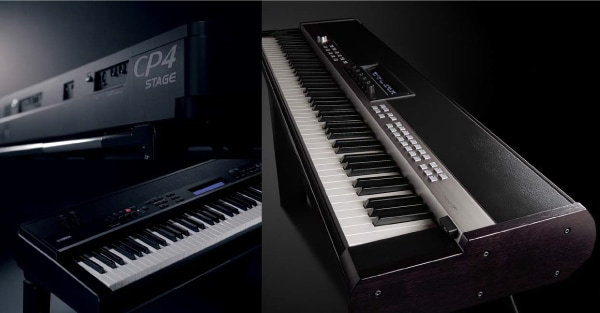
Top left, bottom left: CP4 Right: CP1
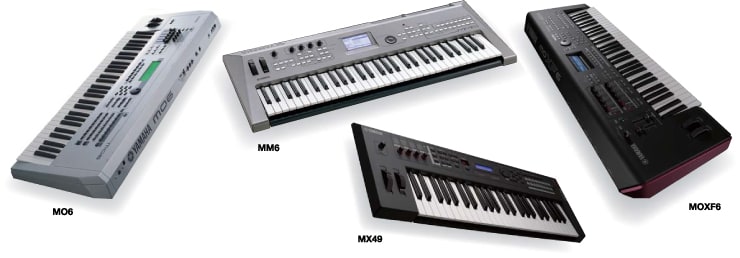
The 40 year journey of the Yamaha synth
From its genesis in the SY-1 of 1974, the rich tradition of the Yamaha synthesizer has evolved through many stages, such as innovation in tone generation systems, advancements in user interfaces, and enrichment of content. This tradition has now been handed down to the MOTIF XF WH that we proudly introduced in 2014. In the seventies and eighties, Yamaha focused on technical innovation in building the fundamental components of keyboard mechanisms and unlocking the secrets of tone generation. The challenging nineties saw a repeated number of trial and error attempts in our quest to understand how the synthesizer could be made a better musical instrument. Over the course of the past decades, we have slowly but surely perfected our craft. Today's MOTIF Series is much loved by musicians all over the world because of Yamaha's application of technical knowhow in the creation of sounds of the same quality as those of acoustic instruments—a policy that was established at the very start of SY-1 development—and our commitment to the production of easy-to-use synthesizers that constantly evolve with the times. The diverse array of technologies and content that we perfected over these 40 years did not merely contribute to the development of an electronic device called the synthesizer: it also helped to stimulate the creativity of countless artists and had an immeasurable impact on music itself in both recording and live settings. Going forward, we can expect Yamaha synthesizers to continue to break ground in the creation of new forms of music hand in hand with artists and musicians.
